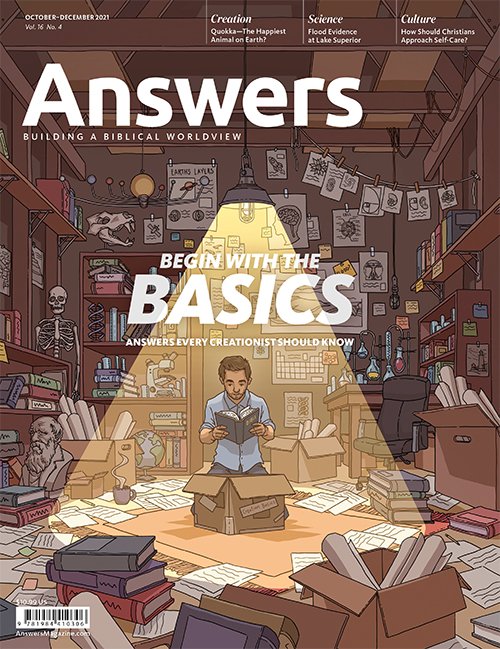
The Designer World: Our Conversation with Prof. Stuart Burgess
Now Streaming: Highlights from Answers.TV
Answers in Genesis offers hundreds of resources that give biblical answers to apologetics questions. Stuart Burgess is a professor of engineering who has obtained seven patents, won multiple awards, and designed parts of rockets and spacecraft. In his talk The Designer World (available to stream on Answers TV or purchase on DVD at AnswersBookstore.com), Professor Burgess highlights numerous intricate designs from creation that show the skill and care of the divine Designer. We recently discussed this topic with him to learn more.
What has engineering shown you about God’s design in nature?
Being an engineer has shown me that the natural world contains designs that are vastly superior to human technology. If you compare the flight capabilities of birds to any manufactured aircraft, you must conclude that birds have a far superior design. Birds have been observed to be blown upside down by powerful gusts during flight, yet they have the agility to fully recover from such disturbances. Engineers can only dream of reproducing such capability. Whatever part of creation you study, it is always superior to human technology.
The superior design of creation shows me that God has wisdom far beyond that of any human designer. But it also provides compelling evidence for intelligent design because if evolution were true, nature would not contain such supreme design. For example, evolutionists argue that humans have poorly designed back and leg joints because, according to the theory of evolution, the transition from four-legged to two-legged walking happened so quickly. The problem for evolution is that there is no evidence that human joints are badly designed. Over the last 20 years, I have published several scientific papers on the design of the human knee joint, describing how it is superbly designed. My Christian faith has been greatly encouraged from the research I have carried out in my own laboratory, showing that humans are fearfully and wonderfully made.
What is one of your favorite examples of design in nature that clearly points to the Designer?
The human hand is one of my favorites because it has a level of sophistication far higher than is required for mere survival. According to evolution, the hand has evolved to perform crude tasks such as throwing spears and punching. However, the human hand is clearly designed to perform very precise tasks like playing musical instruments and writing. The human hand has astounding skill levels due to an amazing network of tendons and muscles that enable each finger and thumb to move with precision in many different directions. The human hand has thousands of touch sensors so sensitive that a fingertip can feel a ridge of just 13 nanometers high (0.000013 mm)—that is less than one thousandth the diameter of a human hair.
What is irreducible complexity?
Irreducible complexity refers to a system that requires several parts to be present and assembled in order for the system to function. Such a system cannot be the result of blind evolution because there are no intermediate forms to bridge the gap between simpler systems and the completed system.
The human blood circulation system is a good example of irreducible complexity because it needs several parts to be fully assembled and integrated to function. Engineers are very familiar with the fact that fluid-pumped circuits need to be completely assembled in order to work. In the case of the human body, there is a short low-pressure circuit to the lungs and a long high-pressure circuit to the body. The heart is a double pump that powers these two separate circuits. An additional clever design feature is that organs are plumbed in parallel (rather than the simpler series arrangement) in order to reduce pressure loss. Such design features must be carefully planned in advance to create a working system. It would be impossible for such a system to evolve step by step as Darwin envisioned.
What does creation reveal about the Creator?
To create trillions of stars requires infinite power. To create a human body with trillions of interconnected cells requires infinite understanding. But creation also reveals the goodness of God. God has designed all kinds of foods such as fruits, vegetables, and grass crops (like wheat, corn, and rice) that are both nutritious and very pleasant for humans to eat. He has also created a world with many aspects of beauty, including the kind that has no other purpose than to add beauty to the world, like bird songs or butterfly wing designs. Jesus remarked on how the glorious beauty of flowers was the result of God’s design (Matthew 6:28). Even though we live in a fallen world, God’s attributes are still clearly seen.
What’s the next step after recognizing that the world was designed by a Creator?
Since God has created the world and every living being, it follows that we are all accountable to him. We have a duty to give thanks to God and to serve him. God left us a written testimony in the form of the Bible. Therefore, we also have a duty to read the Bible and follow its instructions. The most important duty we have is to repent of our sins and put our trust in Jesus.
How can someone use the design argument to start a conversation about God and the gospel?
When I’m with a colleague or friend and we are enjoying a meal together, I sometimes make a comment such as, “Thank God for such well-designed food.” Often the other person will ask why the food is well designed. I then talk about how the food is not just delicious and nutritious but convenient in size and packaging. That can lead to a discussion of God’s goodness, including his greatest act of goodness—sending Jesus into the world to save sinners.
Answers Magazine
October–December 2021
Curious about creation but don’t know where to start? Let’s begin with the basics.
Browse IssueRecommended Resources

Answers in Genesis is an apologetics ministry, dedicated to helping Christians defend their faith and proclaim the good news of Jesus Christ.
- Customer Service 800.778.3390
- Available Monday–Friday | 9 AM–5 PM ET
- © 2025 Answers in Genesis




